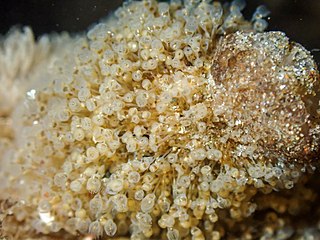
Entoprocta, or Kamptozoa, is a phylum of mostly sessile aquatic animals, ranging from 0.1 to 7 millimetres long. Mature individuals are goblet-shaped, on relatively long stalks. They have a "crown" of solid tentacles whose cilia generate water currents that draw food particles towards the mouth, and both the mouth and anus lie inside the "crown". The superficially similar Bryozoa (Ectoprocta) have the anus outside a "crown" of hollow tentacles. Most families of entoprocts are colonial, and all but 2 of the 150 species are marine. A few solitary species can move slowly.

Stachys affinis, commonly called crosne, Chinese artichoke, Japanese artichoke, knotroot, or artichoke betony, is a perennial herbaceous plant of the family Lamiaceae, originating from China. Its rhizome is a root vegetable that can be eaten raw, pickled, dried or cooked.

Megaloptera is an order of insects. It contains the alderflies, dobsonflies and fishflies, and there are about 300 known species.
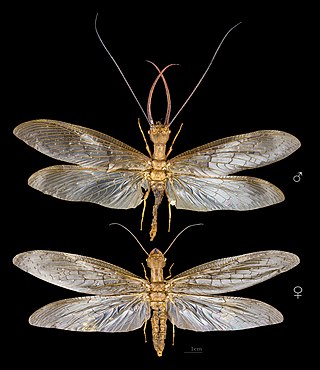
Dobsonflies are a subfamily of insects, Corydalinae, part of the Megalopteran family Corydalidae. The larvae are aquatic, living in streams, and the adults are often found along streams as well. The nine genera of dobsonflies are distributed in the Americas, Asia, and South Africa.

The eastern dobsonfly, Corydalus cornutus, is a large insect in the Corydalidae family. These are known as hellgrammites and are among the top invertebrate predators in the streams in which they live, and are used by anglers as bait.

Corydalus is a genus of large flying insects in the Corydalidae family, commonly known as dobsonflies. They are endemic to North, Central and South America and there are about 35 known species. Members of the genus have wing lengths of up to 85 millimetres. They are sexually dimorphic, with the males having large mandibles used to grasp the females during mating while the females have smaller jaws. The larvae are known as hellgrammites and are aquatic predators.
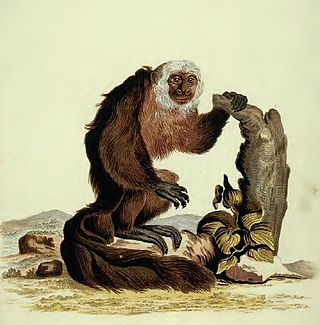
The equatorial saki, also called the red-bearded saki, is a species of saki monkey, a type of New World monkey. It is found in northeastern Peru and Ecuador.

The family Corydalidae contains the megalopterous insects known as dobsonflies and fishflies. Making up about three dozen genera, they occur primarily throughout North America, both temperate and tropical, South America, Australia, New Zealand, Africa and Asia.
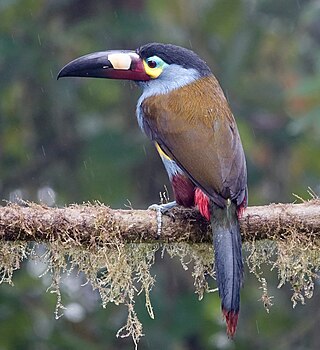
The plate-billed mountain toucan is a species of bird in the family Ramphastidae. It is native to the west slope of Ecuador and extreme southern Colombia, where it lives in the high-altitude humid mountain forests of the Andes.
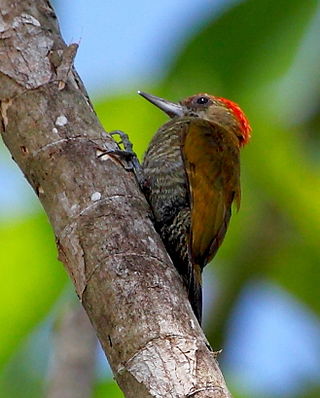
The red-stained woodpecker is a species of bird in subfamily Picinae of the woodpecker family Picidae. It is found in Bolivia, Brazil, Colombia, Ecuador, Peru, and Venezuela.

The hairy little fruit bat is a species of bat in the family Phyllostomidae found in Colombia and Ecuador. They are nocturnal creatures. They are listed as near-threatened by the IUCN.
C. cornutus may refer to:

Protohermes grandis is a species of dobsonfly occurring in China, Japan, Korea, and Taiwan, as well as South and North America, South Africa, Madagascar, Australia, and New Zealand. They are closely related to P. immaculatus. They are the smallest species of Protohermes fly.
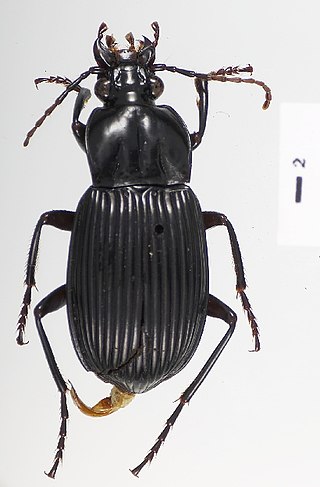
Microcephalus is a genus of in the beetle family Carabidae. There are about 15 described species in Microcephalus, found in South America.
Abraliopsis affinis is a species of enoploteuthid cephalopod in the tropical waters of the eastern Pacific Ocean, and is known from Chile, Colombia, Costa Rica, Ecuador, El Salvador, Guatemala, Honduras, Mexico, Nicaragua, Panama and Peru. It was described by Pfeffer in 1912 and is rated as a least-concern species by the IUCN.

Archichauliodes diversus is an insect in the subfamily Chauliodinae - the fishflies, though it is often referred to as the New Zealand dobsonfly, despite not being a true dobsonfly. In its larval form it is commonly known by the name toe-biter, and its Māori name is puene. The species is native to New Zealand. Although there are many other species of fishfly in other parts of the world, Archichauliodes diversus is the only species of fishfly in New Zealand.
Liodessus affinis is a species of predaceous diving beetle in the family Dytiscidae. It is found in North America.
Corydalus amazonas is a species of dobsonfly in the genus Corydalus. It is endemic to Brazil.

Acanthacorydalis fruhstorferi is a species of dobsonfly native to Vietnam and China. It holds the title of largest aquatic insect by wingspan according to the Guinness Book of World Records at 21.6 cm. The title formerly belonged to the Brazilian damselfly Microstigma rotundatum.

Chloronia is a genus of dobsonflies in the family Corydalidae.














